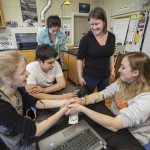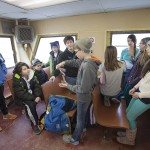Islesboro School's Island Magnetism
On Halloween morning, as the Margaret Chase Smith crossed the silvery reach of Penobscot Bay between Islesboro and the mainland, the passenger compartment was abuzz with the sounds of giggling children putting the final touches on their costumes. The quieter, Carhartt-clad workmen who also rode the ferry for the three-mile-long crossing watched the kids with amused tolerance. They’re accustomed to sharing their morning commute with the mainland kids who attend the 104-student Islesboro Central School through its magnet program.
Once at the dock, the workmen filed off the ferry carrying their coffee cups and lunchboxes next to the students with their backpacks and Halloween costumes. On the island, the two groups split—the men heading off to work on summer houses, and the students and mainland teachers loading into a yellow bus to continue on their way to school.
Patty Crawford of Montville teaches math on the island. She’s seen a lot of students riding the morning ferry over the years, thanks to the school’s successful magnet program, which has grown from its inception in 1997. Beginning in the fifth grade, the mainland “magnets,” as they’re affectionately called in the community, can apply to join the student body. If they’re accepted, their families pay a modest annual tuition to get the kind of personalized education that seems more likely to be offered in a small private school than in a public school.
“The whole reason for the magnet program is to bring some diversity to the island kids,” Crawford said. “Island kids can be so isolated. As the magnet group has gotten larger, it’s gotten easier to integrate. Both groups offer each other something.”
CRITICAL YOUTH MASS
There’s a lot more—the tangible as well as the intangible—that goes into the magnet program’s equation. Having a vibrant, successful school—one whose halls and classrooms are alive with young voices—helps the island’s year-round community remain healthy. And for the mainland students who study English, math, and more in a renovated 1928 summer cottage that is reminiscent of a castle, there’s just something about an island, they say. In particular, there’s something about the close-knit community they find on this one.
“I like that it’s small, and we know everybody,” 11-year-old Caleb Hall of Belfast said. “I really, really like it.”
According to principal Heather Knight, each mainland student is drawn to the island for his or her own reasons. She was, too. The petite administrative powerhouse came here six years ago, after working as the principal of a York County elementary school with 500 students separated into two buildings. There, she often felt more like a manager than an educator. On Islesboro, that’s not the case.
“It’s good to be part of the team,” she said. “I’m not just here to run a school. I’m here to live.”
She believes the magnet program, which helps to keep the school viable, is unique. Its enrollment changes each year as the island population fluctuates, and there’s often a waiting list for the mainland students. They apply from all over the Midcoast—Rockland, Belfast, Montville, Waldo—for the up to 12 slots available in each grade level. Some years, the island is only able to field a couple of off-island students per grade. But their presence is critical, school leaders believe, because mainland pupils help the school achieve a critical mass, which also helps the year-round island community survive, and maybe even thrive.
“In order to reach that goal of sustainable communities, we need to think about bringing up the next generation of islanders, and I think the school will be a magnet for that,” Knight said. “It’s a three-legged stool: school, jobs, and housing. We have one leg of the stool figured out.” Knight feels so good about the school—whose budgets have been passed easily each year by the community, in sharp contrast to the bitter battles waged in nearby mainland districts—that she dreams of broadening that success to other areas. Knight would like to “take on preschool and day care,” creating an affordable, sustainable program for each. “I think young families moving here need that support,” she said.
Longtime islanders like Melissa Olson, the school librarian, said that for a while, the school’s own fate was in question. Before the institution of the magnet program, a sharply fluctuating school population caused residents to question whether the island should shut down the high school.
“We decided we didn’t want that,” she said. “We decided as a community that we wanted to keep this school K through twelve.” To do that, she started advertising the nascent magnet program.
“I said that this is the best-kept secret in education,” Olson said. “It just exploded. It seems to be word-of-mouth, and went from three kids to six to eight, and now we have twenty-seven. It’s a great education.”
Knight said that one welcome side effect of the successful mainland magnet program would be if students and their families, charmed by the island’s unique way of life, decided to move over for good.
ISLAND LIFE LEAP
One student who made that leap is Abby Leidenfrost, 17, who began her academic career being homeschooled by her parents while living deep in the woods of Liberty in western Waldo County. But her parents wanted her to learn to interact with other kids after the eighth grade, recounted the now-confident high school senior.
On Halloween, just before the all-school parade, Abby dropped by the second-floor science lab to touch base with teacher Heather Sinclair about her college applications, and also, just to say a companionable hello.
“I cried for two months when I found out I had to go to public school,” she said. The teen and her family moved to Islesboro full-time during her freshman year. “It took me a while to make friends,” Abby said. “Now that I’m used to the idea of public schools—now that I’m here—I absolutely love this school.”
Sinclair, who has served as the small school’s science department head for six years, has a million-dollar ocean and mountain view out her classroom windows. It’s not hard to imagine the parties that must have been held in the mansion-turned-school when Mrs. J. T. Atterbury of New York built it in 1928. Some students believe that Mrs. Atterbury’s friendly spirit still roams the halls.
But Sinclair seems to have a knack for keeping the kids’ focus on the science happening within her classroom. “I think the magnet program gives us enough size and diversity to keep our classes interesting,” she said, adding that the extra students make it possible to provide a larger selection of courses. “Magnet kids tend to be differently brained. They don’t quite march to the same drummer. The kids come from families that very much value school and education. It keeps a very positive attitude in our school.”
Downstairs, in a fifth-grade classroom, 10-year-old Liefe Temple of Lincolnville busily filled out a Halloween-themed worksheet as other kids in the multiage room worked on their own projects. She said that after checking out Lincolnville Central School last year, she thought it would be cool to go to school on a boat every day, and after attending a Montessori school, the multiage classrooms sounded good to her.
For her parents, who have struggled to find the right school for Liefe, Islesboro had even bigger lures. Jennifer Temple, who, along with her husband, Broo, runs Camden’s Clean Bee Laundry, said that Rockland schools were not the best fit for their daughter.
“She’s a bright little girl. They had to teach to their standardized tests. If that’s not where your kid’s at, she loses her spark,” Temple said.
She and Broo watched that happen to Liefe and then fought back. They moved her to the area Montessori school, “a godsend,” she said, but that only went through the fourth grade, and then the family had to figure out something else. They heard about the Islesboro magnet program, applied, and then held their breath.
“The waiting was hard. We didn’t know what plan B was,” Temple said.
But Liefe was accepted, and so far, plan A is working out great. The tuition, which is a little more than $400 a month, means that the Temples have had to make some changes to their lifestyle. They’ve cut out cable TV and otherwise have limited their spending, and in exchange they’ve received something they find invaluable.
“Our thought is that it’s really an investment now into their future,” she said, adding that Liefe’s eight-year-old sister aspires to go to Islesboro and take the “bus boat” to school one day, too. “To keep their love of learning alive is more important than having new gadgets.”
Temple said that the school has helped to ease Liefe’s transition. Although it’s not possible to just drive by and drop off a forgotten item, the school does arrange for the Quicksilver ferry to bring families home from evening events, and helps every mainland magnet student find a host family. Liefe can stay with hers if the weather is too bad to come home, or if she needs a place to eat dinner before a school function.
“We’re very pleased; it’s been great for our family. We would definitely recommend to other families that maybe if their kid hasn’t quite found their spot, they should explore Islesboro,” she said.
LOOKING BACK
One early magnet program graduate, 25-year-old Skye Lawrence, originally of Belfast, cautioned that such a small school might not be for everybody. The Harvard Business School researcher said that she started at Islesboro Central School in sixth grade after her older brother had a tough time in the mainland middle school.
“The thing about Islesboro for someone who is self-motivated and wants to do independent things is that there’s a lot of leeway. It’s so small, you don’t get lost in the shuffle,” she said. “The personal attention you get at Islesboro is amazing.”
But the school’s small size can create its own limitations. “A drawback is that because there’s only one teacher per subject, if there’s not a good student-teacher rapport, there isn’t space for finding a better fit,” she said. “It’s a logistical disadvantage.”
Nonetheless, island parents feel that the magnet program expands their own kids’ academic and social experiences. Beth Howell, the fourth- and fifth-grade teacher, said that her son was the only island boy in his grade level. “The magnet allows him to have a peer group,” she said, adding that he was going trick-or-treating in Belfast that night with his school friends from the mainland. “I love it. I think it’s a win-win for both sides.”
Abi Martin of Belfast and Monroe, 11, has an atypical story, apart from her enthusiasm for the school. She was midway through fifth grade last year when she hit a tree while skiing at Sugarloaf, fracturing her skull and sustaining other serious injuries. Abi was just beginning her long recovery at Eastern Maine Medical Center in Bangor when she received a special care package from her schoolmates—each one of them.
“The whole school made paper cranes for me,” she said.
That origami gift of hope, made under the tutelage of a fellow mainland classmate’s Japanese mother, flew on a hanger in her hospital room as she worked to get better. And when Abi returned to classes months later, she still felt like part of the school family—something that helped a lot during a very hard time, her father, Jeremy Martin, said later.
“The day of the accident, the parents, the kids, everyone, kind of stepped up and put out their love, their hearts, and everything they had for Abi, her mother, and me,” he said.
When she returned to school, the administration purchased books about children who had suffered traumatic brain injuries, and Abi’s teacher “jumped into them,” Martin said. “The school did not hesitate. ‘Abi’s staying at our school, and we’re going to make it work for her.’ It was not a question,” he said.
When Abi had a medical setback in June, the principal asked her family if they’d mind if she reached out to the broader island community for ideas or help. One islander with a connection to Tufts Medical Center said he’d have his staff look at Abi’s files, and she ended up having an important surgery at the world-class Boston facility.
“Maine is a small state; islands are even smaller,” Jeremy Martin said. “You tend to know people, and it appears it’s paid off for Abi. It’s amazing where she’s at. She’s doing A and B work in everything now.”
Abi was an enthusiastic participant in a small study group in the library on the day of my visit, going over writing prompts with her teacher and two other students.
“I like how there aren’t so many kids,” she said. “I like that it’s small . . . The middle school in Belfast was too big, with too many people. When my mom and dad were talking about this, I said, ‘Mom! Dad! I want to go there instead.’ ”






